The Hydrogen Trade-Off: Optimizing Decarbonization Pathways for Urban Integrated Energy Systems
Abstract
1. Introduction
2. Energy Development Modeling
2.1. Model Building
2.1.1. Modeling Framework
2.1.2. Mathematical Expression
- i.
- Electricity sector
- ii.
- Transportation sector
- iii.
- Industry sector
2.2. Energy Forecasting Model
2.2.1. Energy Demand Projections
2.2.2. Renewable Energy Supply Projections
3. Hydrogen Energy Scenario Penetration Modeling
3.1. Modeling of Hydrogen End-Use Energy Penetration
- i.
- Modeling hydrogen penetration in the electricity sector
- ii.
- Modeling hydrogen penetration in the industry sector
- iii.
- Modeling hydrogen penetration in the transportation sector
3.2. Hydrogen Energy Application Scenario Construction
- i.
- Basic energy inertia scenario (BEIS)
- ii.
- Climate response pioneer scenario (CRPS)
- iii.
- Policy-driven scenario (QPDS)
- iv.
- China Hydrogen Alliance Potential Scenario (CHAPS)
4. Energy Evaluation Modeling
4.1. Construction of Evaluation Indicators
- i.
- Economic indicators
- ii.
- Environmental indicators
- iii.
- Technical indicators
4.2. Empowerment Ranking Model Construction
4.2.1. Entropy Weight Method
- i.
- Establish the original matrix [Xij]m×n with n evaluation objects and m evaluation indicators.
- ii.
- To eliminate the influence of dimensions, all indicators are first standardized. For positive indicators Yij+ and negative indicators Yij−, the maximum–minimum value standardization method is typically used to map them to the [0, 1] interval.
- iii.
- We need to calculate the indicator weight Dij and perform data translation. If the standardized data contains a value of 0 for Yij, this will result in a weight Dij of 0, rendering the entropy calculation meaningless. To ensure that all logarithmic values are meaningful, we perform a slight “translation” on the data, i.e., add a very small positive number d to all data.
- iv.
- Information entropy qj is a measure of information uncertainty. According to the definition of information theory, the formula for calculating the information entropy of the jth indicator is shown in Equation (27).
- v.
- Perform the weight calculation as shown in Equation (28).
4.2.2. Technique for Order Preference by Similarity to Ideal Solution (TOPSIS) Decision Theory
- i.
- The normalized initial matrix is constructed, in which the Euclidean quantum normalization method is used to construct the weighting method matrix and vector normalization, where each column element is divided by the current parameter of the column vectors to get the normalized normalized matrix Z.
- ii.
- The calculation of points and the normalization process is followed by decision-making. In decision-making, there are ideal and non-ideal points. Ideal point Z+ consists of the maximum value of the elements of each column in matrix Z, non-ideal point Z− consists of the minimum value of the elements of each column in matrix Z. In deciding how to choose the best compromise program, the distance between the evaluation object and the two ideal points is considered comprehensively as an evaluation criterion. The distance between the evaluation object and the ideal point is calculated as shown in Equation (30).
5. Example Results and Analysis
5.1. Results of Energy Demand Projections
- i.
- Electricity energy demand forecasting model
- ii.
- Industry energy demand forecasting model
- iii.
- Transportation Energy Demand Forecasting Model
5.2. Results of Renewable Energy Supply Projections
5.3. Cost Projections
6. Results
6.1. Analysis of Hydrogen Decarbonization Pathway Simulation Results
6.1.1. Analysis of the Evolution of the Energy Structure
6.1.2. Carbon Emission Analysis
6.1.3. System Cost Analysis
6.2. Evaluation of Hydrogen Decarbonization Pathway Simulation Results
6.3. Evaluation of Electricity Supply and Demand Simulation Results
7. Discussion
7.1. Research Limitations
- i.
- The use of a priori settings for cross-sectoral hydrogen allocation, with fixed hydrogen substitution efficiencies for fossil fuels, reduces hydrogen utilization in the industrial sector to coal substitution and injection into natural gas pipeline networks. Whereas hydrogen substitution efficiencies are closely related to specific application technologies (such as gas turbine hydrogen doping ratios) and are dynamic parameters, the use of fixed values makes it difficult to adequately capture the impact of technical details on system energy efficiency. The industrial sector has been neglected in terms of the use of hydrogen as a chemical feedstock or high-temperature process, which feature significant differences in economics and abatement potential, which in turn may underestimate the role of hydrogen in industrial decarbonization. Ideally, hydrogen allocation should be dynamically optimized based on the marginal abatement cost of each sector, and preset values make it difficult to achieve the global optimum of the system.
- ii.
- The model’s key technology costs and fossil fuel prices are projected using linear trends, and the selected future data and efficiency parameters are more optimistic. Whereas the cost reductions of hydrogen-related technologies show a non-linear “learning curve” characteristic, static or linear projections may overestimate the long-term costs of hydrogen penetration scenarios. At the same time, international fuel prices and future carbon pricing mechanisms are subject to large uncertainties, and a fixed forecast curve is difficult to make cover the risk of future fluctuations, all of which can affect the accuracy of the model’s economic assessment.
- iii.
- The core of this study is an EnergyPLAN-based energy flow balance simulation, which focuses on “hydrogen use side analysis”, but the hydrogen energy supply chain and infrastructure modeling is insufficient, and the costing and layout modeling of “hydrogen supply side” infrastructure, i.e., the whole chain of “production–storage–delivery–use”, has not been carried out in detail, and the model lacks a dynamic optimization mechanism for selecting among green, blue, and gray hydrogen sources. There is no detailed costing and layout modeling of the “hydrogen supply side” infrastructure, i.e., the whole chain of “production–storage–delivery–use”, and the existing models only consider hydrogen as a usable fuel input, which may underestimate the overall social costs required to realize each scenario.
- iv.
- The model analyzes Jinan as a single energy node without considering the spatial heterogeneity within the city, and there are limitations in the spatial resolution of the model, thus ignoring issues such as regional grid transmission bottlenecks, natural gas pipeline network hydrogen doping limitations, and mismatches between the geographic distribution of renewable energy sources, such as photovoltaics, and load centers, etc. In fact, the siting of large-scale electrolytic water-to-hydrogen plants is subject to stringent constraints in terms of grid access capacity and water resource conditions. Such spatial factors can adversely affect the overall layout and operating costs of the system.
7.2. Future Research Perspectives
- i.
- Future research will construct more refined sub-sector models and develop more refined sub-models for the characteristics of hydrogen use in different sectors. In the transportation sector, dynamic models will be constructed based on the ownership, penetration, and behavioral patterns of different vehicle types (fuel cell vehicles and hydrogen internal combustion engine vehicles). In the industrial sector, different uses of hydrogen as a fuel and raw material will be distinguished and modeled in conjunction with specific industrial processes to more accurately assess hydrogen’s emissions reduction potential and economic value.
- ii.
- In the future, we will embed dynamic learning curves for key technologies in our model, dynamically depicting how costs change over time and scale of deployment. At the same time, using stochastic planning or multi-scenario analysis to cope with the uncertainties in the external environment, such as fuel prices and carbon prices, to assess the robustness of different decarbonization paths, and ultimately to propose more adaptive strategic recommendations.
- iii.
- In the future, the existing energy system model will be deeply integrated with the geographic information system to carry out spatial and temporal optimization studies for the whole chain of hydrogen energy “production–storage–transmission–use”, and optimize the siting and scale of hydrogen production facilities, storage, and refueling stations, taking into account the endowment of renewable energy resources, water resources distribution, constraints of power grids and pipeline networks, land use, and safety distances. Thus, we will form a blueprint for the development of hydrogen energy infrastructure that is spatially feasible and economically reasonable.
- iv.
- Extend the research scope from technical and economic analysis to socio-economic areas, explore the effectiveness of subsidy policies, carbon trading mechanisms, and a hydrogen certificate system on the development of hydrogen energy, assess the pulling effect of the hydrogen industry on local employment and economic growth, and analyze the public’s acceptance of hydrogen energy infrastructure through questionnaire surveys, in order to provide more comprehensive support to policy formulation, a more accurate portrayal of the role of hydrogen energy in the urban energy transition, and guidance for the scientific operation of the path to achieve the “dual carbon” goal.
8. Conclusions
- i.
- The Hydrogen Alliance Potential Scenario has the best performance in decarbonization, with CO2 emission reduction potential and unit emission reduction cost improve by 7.98% and 29.39%, respectively, and renewable energy power generation and primary energy share increased by 89.9% and 4.9% in 2035 compared with the baseline energy inertia scenario, showing the strongest carbon emission reduction capability and renewable energy consumption potential.
- ii.
- The comprehensive evaluation results show that the Hydrogen Alliance Potential Scenario ranks first with a relative closeness of 0.5961, which is closest to the ideal state in terms of the balance of cost, environment, and sustainability indicators. The Policy-Driven Scenario has the lowest score (0.3154), which indicates that hydrogen penetration is not “the higher the better” and that the selection of an appropriate solution needs to be combined with the actual needs of the system.
- iii.
- Hydrogen penetration has a positive effect on the optimization of the energy structure. As the share of hydrogen in end-fuel consumption increases in all scenarios, the expansion of the installed capacity of electrolysis tanks effectively reduces the critical excess power and improves the stability of the system. However, the current proportion of hydrogen in the total energy consumption is still low, reflecting that the cost of the technology and the construction of the infrastructure are still the main constraints.
- iv.
- In terms of system costs, the annual costs of the hydrogen-containing scenarios are all higher than those of the baseline energy inertia scenario, mainly due to the inputs of hydrogen production and coal-to-hydrogen with CCS technology. However, the costs of the scenarios take on a downward trend after 2029, which predicts that with the decrease in the proportion of fossil energy sources, the economics of the hydrogen energy system will gradually improve.
Author Contributions
Funding
Data Availability Statement
Acknowledgments
Conflicts of Interest
Appendix A
Appendix A.1. Data Sources and Variable Descriptions
Appendix A.2. Regression Analysis Methods
- i.
- Perform significance tests on the model by first conducting t-statistic on each regression coefficient to calculate their significance p-values. Typically, the significance level α = 0.05. If p > 0.05, it is concluded that the independent variable has no significant effect on the dependent variable and should be removed from the model.
- ii.
- The F statistic reflects the extent to which all independent variables in the model collectively explain the variation in the dependent variable. The larger the F statistic, the more significant the linear relationship in the model. If the significance of the F-test < 0.05, it indicates that the regression model is statistically significant and meaningful overall.
- iii.
- Next, the goodness of fit of the model is assessed using the adjusted R2 to evaluate the model’s overall explanatory power. A higher adjusted R2 indicates better model fit to the data.
Appendix A.3. Regression Analysis Methods
Appendix A.3.1. Regression Results of the Electricity Demand Model
| Variable | Coefficient of Regression | Standard Error | t-Statistic | p-Value |
|---|---|---|---|---|
| lnDEl | 24.002 | 9.620 | 2.495 | 0.014 |
| lnGDP | 0.193 | 0.086 | 2.244 | 0.027 |
| lnSec | 1.378 | 0.492 | 2.801 | 0.006 |
| lnUrb | 8.783 | 0.433 | 20.284 | <0.001 |
| lnEte | −3.586 | 1.379 | −2.600 | 0.011 |
| Indicator | Numerical Value |
|---|---|
| R2 | 0.988 |
| Adjusted R2 | 0.986 |
| F statistic | 578.377 |
| Significance of F-test | <0.001 |
| Note: Significance level α = 0.05 |
Appendix A.3.2. Regression Analysis Results of the Industrial Sector Energy Demand Forecast Model
| Variable | Coefficient of Regression | Standard Error | t-Statistic | p-Value |
|---|---|---|---|---|
| lnDIn | −14.001 | 3.931 | −3.562 | 0.002 |
| lnGDP | 0.733 | 0.066 | 11.106 | <0.001 |
| lnSec | 1.093 | 0.369 | 2.962 | 0.004 |
| lnUrb | −0.34 | 0.141 | −2.411 | 0.025 |
| lnEte | 4.02 | 0.905 | 4.442 | <0.001 |
| Indicator | Numerical Value |
|---|---|
| R2 | 0.982 |
| Adjusted R2 | 0.980 |
| F statistic | 460.89 |
| Significance of F-test | <0.001 |
| Note: Significance level α = 0.05 |
Appendix A.3.3. Regression Analysis Results of the Transportation Sector Energy Demand Forecast Model
| Variable | Coefficient of Regression | Standard Error | t-Statistic | p-Value |
|---|---|---|---|---|
| lnDET | −23.071 | 7.967 | −2.896 | 0.005 |
| lnGDP | 1.254 | 0.133 | 9.429 | <0.001 |
| lnSec | 1.354 | 0.613 | 2.210 | 0.032 |
| lnUrb | −1.997 | 0.287 | −6.966 | <0.001 |
| lnEte | 4.763 | 1.835 | 2.596 | 0.023 |
| Indicator | Numerical Value |
|---|---|
| R2 | 0.985 |
| Adjusted R2 | 0.982 |
| F statistic | 256.708 |
| Significance of F-test | <0.001 |
| Note: Significance level α = 0.05 |
References
- Pu, Z.; Yi, T. Low-carbon economic energy sharing and revenue distribution strategy for multi-integrated energy systems considering the uncertainty of new energy output. Sustain. Energy Grids Netw. 2025, 43, 101757. [Google Scholar] [CrossRef]
- Wang, Y.; Zhou, H.; Ma, K.; Jiang, S.; Zhu, M. Dynamic pricing and low-carbon economy dispatch of multi-park integrated energy system based on mixed game. Electr. Power Syst. Res. 2025, 248, 111908. [Google Scholar] [CrossRef]
- Cordioli, E.; Maigret, J.d.; Testi, M.; Crema, L. Green hydrogen in the Alps: Mapping local stakeholders perspectives and identifying opportunities for decarbonization. Energy Rep. 2025, 14, 128–140. [Google Scholar] [CrossRef]
- Wang, Z.; Mu, X.; Ma, Y.; Liao, P.; Ji, Y.; Han, F. Advanced energy management and optimal scheduling for integrated offshore gas-hydrogen-electricity-heat systems. Energy 2025, 319, 135091. [Google Scholar] [CrossRef]
- Zhang, Z.; Xu, Y.; Yu, Y.; Chen, X.; Liao, H. Stochastic multiple criteria decision-making for configuration selection of electricity-hydrogen integrated energy systems with multiple stakeholder interest coordination. Eng. Appl. Artif. Intell. 2025, 157, 111323. [Google Scholar] [CrossRef]
- Wade, F.; Roche, R.; Chailan, A.; Bertrand, V.; Paire, D. Optimal sizing and energy management of an integrated energy system coupling a hydrogen-fueled gas turbine with storage for Power-to-Power and hydrogen supply. Int. J. Hydrogen Energy 2025, 135, 31–47. [Google Scholar] [CrossRef]
- Wu, K.; Jiang, M.; Huang, Y.; Dai, Z.; Wang, X.; Duan, Z.; Wang, Y.; Li, G. Optimization of multi-objective capacity allocation and performance analysis for integrated energy systems considering hydrogen storage. Energy 2025, 325, 136160. [Google Scholar] [CrossRef]
- Xu, X.; Wang, B.; Shi, M.; Li, G.; Zhang, Y.; Wang, Q.; Liu, D. Research on hydrogen storage system configuration and optimization in regional integrated energy systems considering electric-gas-heat-hydrogen integrated demand response. Int. J. Hydrogen Energy 2025, 135, 86–103. [Google Scholar] [CrossRef]
- Yang, S.; Yan, R.; Zhang, J.; Wang, J.; Bai, Z.; He, Y.; Hu, K.; Ao, X. Nested long-short-term temporal compression optimization for high-renewable integrated energy systems with hydrogen storage and heat recovery. Energy 2025, 333, 137423. [Google Scholar] [CrossRef]
- Wu, T.; Wang, J.; Zhao, T. Coordinated planning of integrated energy system with hydrogen hub. Appl. Energy 2025, 394, 126089. [Google Scholar] [CrossRef]
- Li, X.; Du, Y.; Tan, Z.; He, H.; Fan, W. Optimal operation model of electrothermal integrated energy system including hydrogen production from offshore wind power participating in multi-level market. Int. J. Hydrogen Energy 2025, 114, 250–266. [Google Scholar] [CrossRef]
- Lu, S.; Cui, M.; Gao, B.; Liu, J.; Ni, J.; Liu, J.; Zhou, S. A Comparative Analysis of Machine Learning Algorithms in Predicting the Performance of a Combined Radiant Floor and Fan Coil Cooling System. Buildings 2024, 14, 1659. [Google Scholar] [CrossRef]
- Ding, Y.; Lu, S.; Li, T.; Zhu, Y.; Wei, S.; Tian, Z. An indoor thermal environment control model based on multimodal perception and reinforcement learning. Build. Environ. 2025, 276, 112863. [Google Scholar] [CrossRef]
- Lu, S.; Zhou, S.; Ding, Y.; Kim, M.K.; Yang, B.; Tian, Z.; Liu, J. Exploring the comprehensive integration of artificial intelligence in optimizing HVAC system operations: A review and future outlook. Results Eng. 2025, 25, 103765. [Google Scholar] [CrossRef]
- Dong, X.; Zhao, Y. An economic way to reduce emissions of industrial parks with hydrogen-based integrated energy systems. Int. J. Hydrogen Energy 2025, 106, 1122–1133. [Google Scholar] [CrossRef]
- Wang, Y.; Qin, Y.; Ma, Z.; Wang, Y.; Li, Y. Operation optimisation of integrated energy systems based on cooperative game with hydrogen energy storage systems. Int. J. Hydrogen Energy 2023, 48, 37335–37354. [Google Scholar] [CrossRef]
- Yang, Z.; Cheng, L.; Min, H.; Lei, Y.; Yang, Y. Distributionally robust optimization-based scheduling for a hydrogen-coupled integrated energy system considering carbon trading and demand response. Glob. Energy Interconnect. 2025, 8, 175–187. [Google Scholar] [CrossRef]
- Zhan, Z.; Xu, J.; Zhang, T.; Kong, X.; Li, H.; Zhang, B. Optimal scheduling of integrated wind- photovoltaic-hydrogen energy system considering hydrogen application and waste heat recovery. Energy Rep. 2024, 11, 3684–3694. [Google Scholar] [CrossRef]
- Sohani, A. Time-dependent energy, economic, and environmental assessment of a PV-hydrogen integrated power system. Int. J. Hydrogen Energy 2025, 144, 964–976. [Google Scholar] [CrossRef]
- Liu, X.; Zu, L.; Wei, Z.; Wang, Y.; Pan, Z.; Xiao, G.; Jenkins, N. Two-layer optimal scheduling of integrated electric-hydrogen energy system with seasonal energy storage. Int. J. Hydrogen Energy 2024, 82, 1131–1145. [Google Scholar] [CrossRef]
- Fang, X.; Dong, W.; Wang, Y.; Yang, Q. Multi-stage and multi-timescale optimal energy management for hydrogen-based integrated energy systems. Energy 2024, 286, 129576. [Google Scholar] [CrossRef]
- Judge, M.A.; Franzitta, V.; Curto, D.; Marvuglia, A. Cost-effective optimization of energy system integrated with hybrid battery-hydrogen storage: A techno-economic and environmental analysis for the sustainable electrification of a university campus. J. Energy Storage 2025, 130, 117133. [Google Scholar] [CrossRef]
- Joseph, A.; Allahham, A.; Walker, S.L. Investment decisions in a liberalised energy market with generation and hydrogen-based vector coupling storage in Integrated Energy System: A game-theoretic model-based approach. Int. J. Electr. Power Energy Syst. 2025, 166, 110518. [Google Scholar] [CrossRef]
- Li, J.; Chen, H.; Qi, Y.; Wang, Y.; Lei, J. Collaborative optimization for cross-regional integrated energy systems producing electricity-heat-hydrogen based on generalized Nash bargaining. Energy 2025, 333, 137444. [Google Scholar] [CrossRef]
- Lund, H.; Thellufsen, J.Z.; Østergaard, P.A.; Sorknæs, P.; Skov, I.R.; Mathiesen, B.V. EnergyPLAN–Advanced analysis of smart energy systems. Smart Energy 2021, 1, 100007. [Google Scholar] [CrossRef]
- Amil, C.; Yılmazoğlu, M.Z. The importance of hydrogen for energy diversity of Turkey’s energy production: 2030 projection. Int. J. Hydrogen Energy 2022, 47, 19935–19946. [Google Scholar] [CrossRef]
- Koivunen, T.; Khosravi, A.; Syri, S. The role of power–to–hydrogen in carbon neutral energy and industrial systems: Case Finland. Energy 2023, 284, 128624. [Google Scholar] [CrossRef]
- Maaouane, M.; Zouggar, S.; Krajačić, G.; Zahboune, H. Modelling industry energy demand using multiple linear regression analysis based on consumed quantity of goods. Energy 2021, 225, 120270. [Google Scholar] [CrossRef]
- Nicoară-Farcău, O.; Wang, X.; Luo, X. Definition of SPSS: We need to speak the same language. J. Hepatol. 2020, 73, 463–464. [Google Scholar] [CrossRef]
- Wang, X.; Cheng, T.; Hong, H.; Guo, H.; Lin, X.; Yang, X.; Nie, B.; Hu, Z.; Zou, J. Challenges and opportunities in hydrogen storage and transportation: A comprehensive review. Renew. Sustain. Energy Rev. 2025, 219, 115881. [Google Scholar] [CrossRef]
- Ali, N.; Tormene, F. An innovative method for blending hydrogen into natural gas. Int. J. Hydrogen Energy 2025, 148, 150038. [Google Scholar] [CrossRef]
- IEA. Net Zero by 2050. 2021. Available online: https://www.iea.org/reports/net-zero-by-2050 (accessed on 27 May 2025).
- Prina, M.G.; Dallapiccola, M.; Moser, D.; Sparber, W. Machine learning as a surrogate model for EnergyPLAN: Speeding up energy system optimization at the country level. Energy 2024, 307, 132735. [Google Scholar] [CrossRef]
- Villasante, A.; Fernández-Serrano, Á.; Osuna-Sequera, C.; Hermoso, E. Methodology for stiffness prediction in structural timber using cross-validation RMSE analysis. J. Build. Eng. 2025, 107, 112767. [Google Scholar] [CrossRef]
- Bamisile, O.; Wang, X.; Adun, H.; Joseph Ejiyi, C.; Obiora, S.; Huang, Q.; Hu, W. A 2030 and 2050 feasible/sustainable decarbonization perusal for China’s Sichuan Province: A deep carbon neutrality analysis and EnergyPLAN. Energy Convers. Manag. 2022, 261, 115605. [Google Scholar] [CrossRef]
- IEA. Global Energy Review 2025. 2025. Available online: https://www.iea.org/reports/global-energy-review-2025 (accessed on 13 June 2025).
- Ross-Hopley, D.; Rahman, S.; Ugwu, L.; Ibrahim, H. Techno-economic opportunities for integration of renewable energy into the Saskatchewan energy system using EnergyPLAN. Energy 2025, 318, 134903. [Google Scholar] [CrossRef]
- Ouyang, Y.; Shen, Z.; Zuo, Q.; Li, Q.; Ma, Y.; Zhang, H. Investigation of rotary proton exchange membrane fuel cell performance optimization based on orthogonal experiment and entropy weight method. Appl. Therm. Eng. 2025, 272, 126362. [Google Scholar] [CrossRef]
- Wang, Y.; Zhong, K.; He, J.; Kang, Y. Numerical study on balancing air quality in streets and adjacent neighborhoods using combined porous media model and TOPSIS method. Build. Environ. 2025, 282, 113219. [Google Scholar] [CrossRef]
- Mi, Z.; Yuan, B.; Zhang, J. Study on the Scale of New Energy Development during the 14th Five-Year Plan Period. IOP Conf. Ser. Earth Environ. Sci. 2019, 371, 042059. [Google Scholar] [CrossRef]
- Su, Y.; Liu, H.; Su, H.; Sun, L. Coupling analysis of land space development and protection and economic and social development in Julu County. IOP Conf. Ser. Earth Environ. Sci. 2020, 602, 012014. [Google Scholar] [CrossRef]
- Wang, C.; Cao, Y. Forecasting Chinese economic growth, energy consumption, and urbanization using two novel grey multivariable forecasting models. J. Clean. Prod. 2021, 299, 126863. [Google Scholar] [CrossRef]
- Liu, Z.; Huang, X.; Qi, X. Economic effect of China’s carbon neutrality target under shared socioeconomic pathways. Sci. China Earth Sci. 2025, 68, 142–157. [Google Scholar] [CrossRef]
- Mallapaty, S. How China could be carbon neutral by mid-century. Nature 2020, 586, 482–483. [Google Scholar] [CrossRef] [PubMed]
- Dai, J.; Yang, X.; Wen, L. Development of wind power industry in China: A comprehensive assessment. Renew. Sustain. Energy Rev. 2018, 97, 156–164. [Google Scholar] [CrossRef]
- Franke, K.; Garcia, J.F.; Kleinschmitt, C.; Sensfuß, F. Assessing worldwide future potentials of renewable electricity generation: Installable capacity, full load hours and costs. Renew. Energy 2024, 226, 120376. [Google Scholar] [CrossRef]
- Wang, X.; Teng, F.; Yang, X.; Wei, R. Assessing the Role of Electricity Storage in China’s High Renewable Energy Penetration Future. Energy Procedia 2017, 105, 4084–4089. [Google Scholar] [CrossRef]
- Chepeliev, M.; van der Mensbrugghe, D. Global fossil-fuel subsidy reform and Paris Agreement. Energy Econ. 2020, 85, 104598. [Google Scholar] [CrossRef]
- Li, S.; Kong, W.; Wang, Y.; Yuan, L. Medium and long-term energy demand forecasts by sectors in China under the goal of “carbon peaking & carbon neutrality”: Based on the LEAP-China model. Energy 2024, 310, 133017. [Google Scholar]
- Mercure, J.F.; Pollitt, H.; Viñuales, J.E.; Edwards, N.R.; Holden, P.B.; Chewpreecha, U.; Salas, P.; Sognnaes, I.; Lam, A.; Knobloch, F. Macroeconomic impact of stranded fossil fuel assets. Nat. Clim. Change 2018, 8, 588–593. [Google Scholar] [CrossRef]
- Gugler, K.; Haxhimusa, A.; Liebensteiner, M. Carbon pricing and emissions: Causal effects of Britain’s carbon tax. Energy Econ. 2023, 121, 106655. [Google Scholar] [CrossRef]
- Zhang, M.; Cong, N.; Song, Y.; Xia, Q. Cost analysis of onshore wind power in China based on learning curve. Energy 2024, 291, 130459. [Google Scholar] [CrossRef]
- Zhao, C.; Zhang, W.; Wang, Y.; Liu, Q.; Guo, J.; Xiong, M.; Yuan, J. The economics of coal power generation in China. Energy Policy 2017, 105, 1–9. [Google Scholar] [CrossRef]
- Saravanan, A.; Yaashikaa, P.R.; Kumar, P.S.; Thamarai, P.; Deivayanai, V.C.; Rangasamy, G. A comprehensive review on techno-economic analysis of biomass valorization and conversional technologies of lignocellulosic residues. Ind. Crops Prod. 2023, 200, 116822. [Google Scholar] [CrossRef]
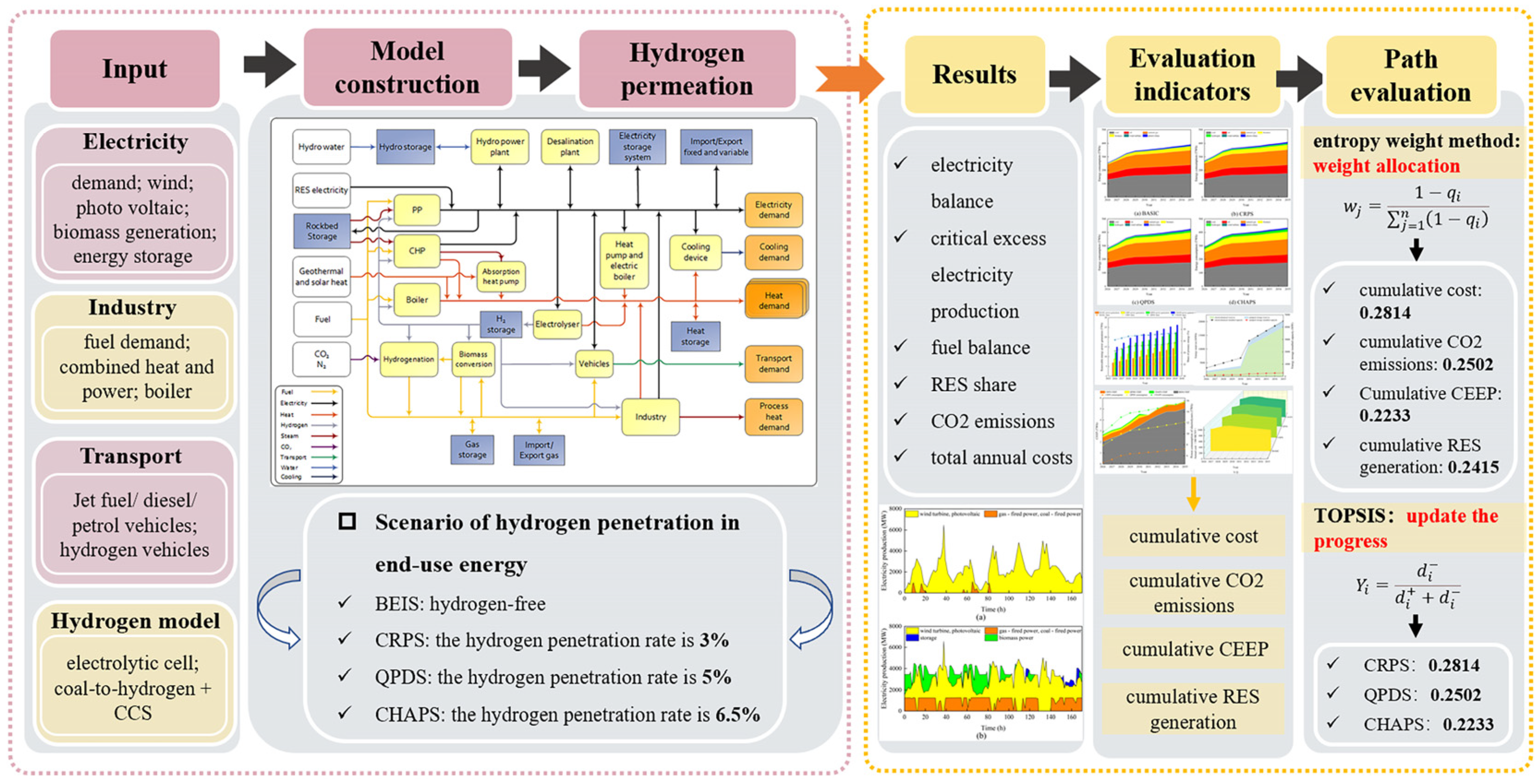
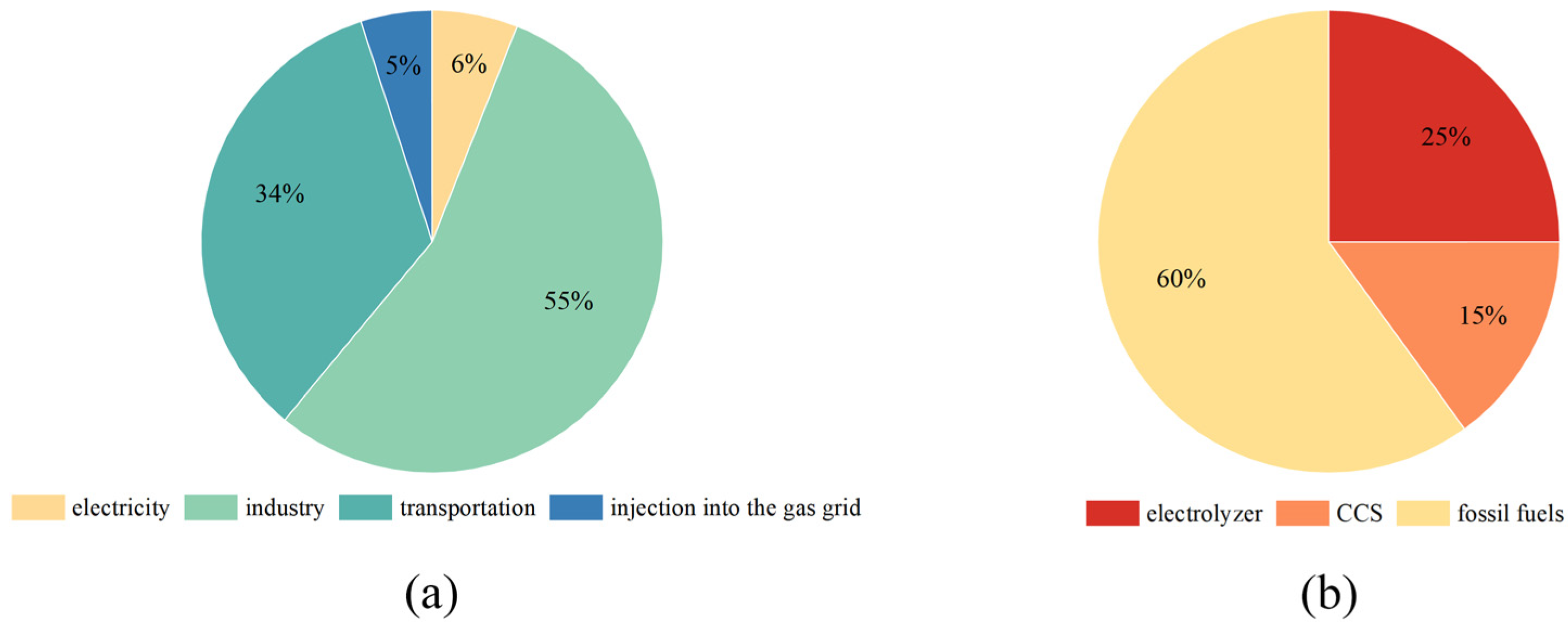


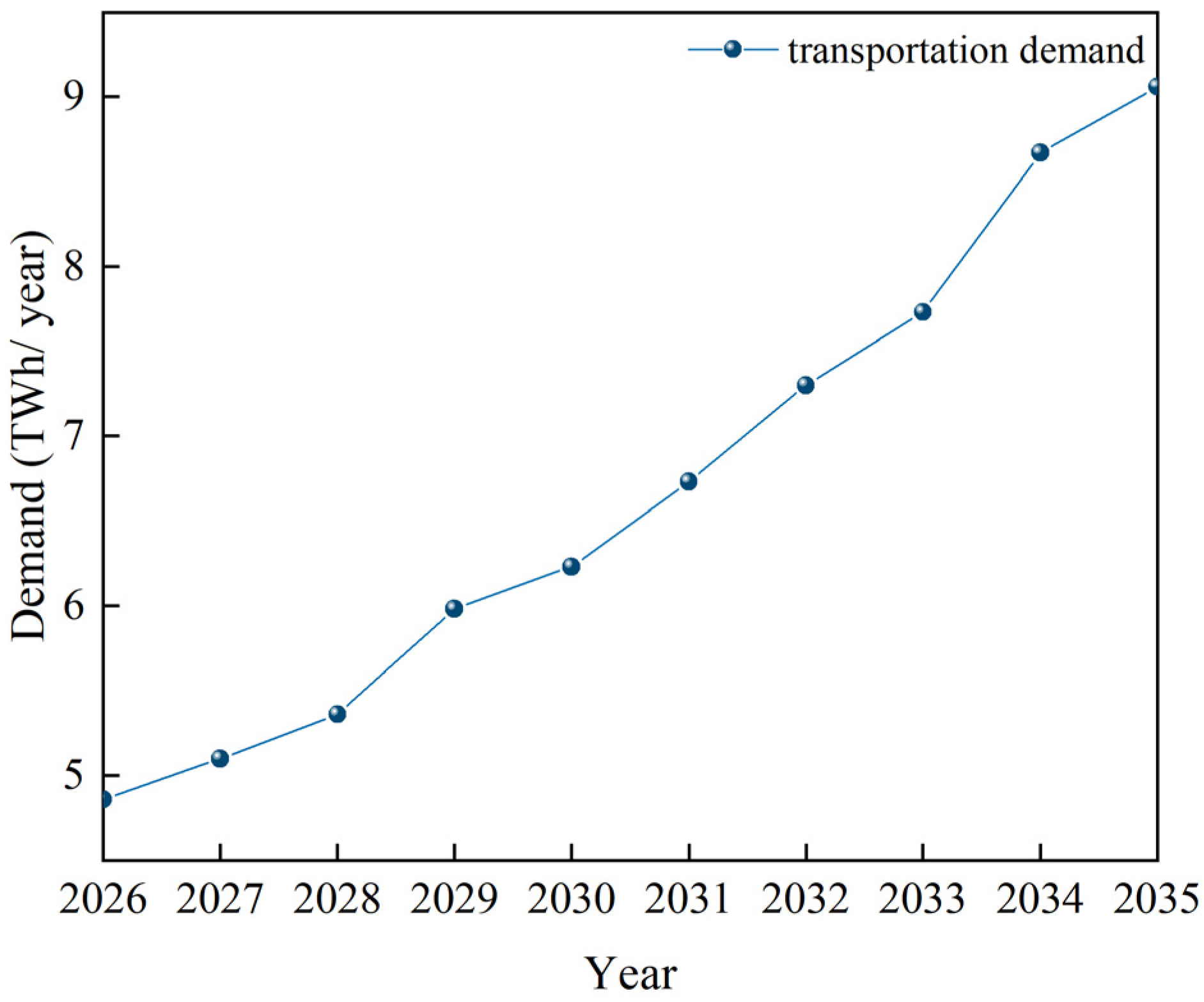
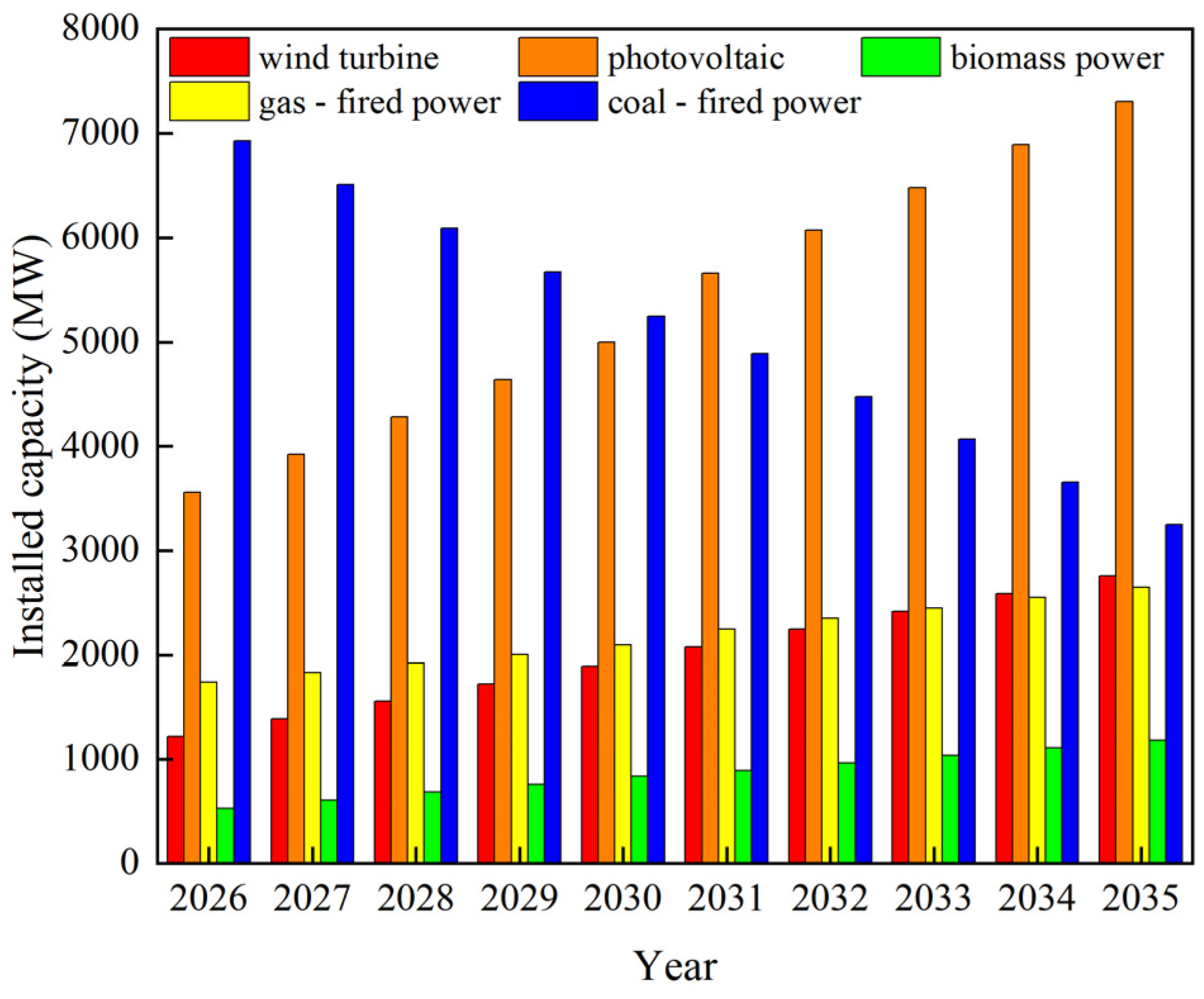
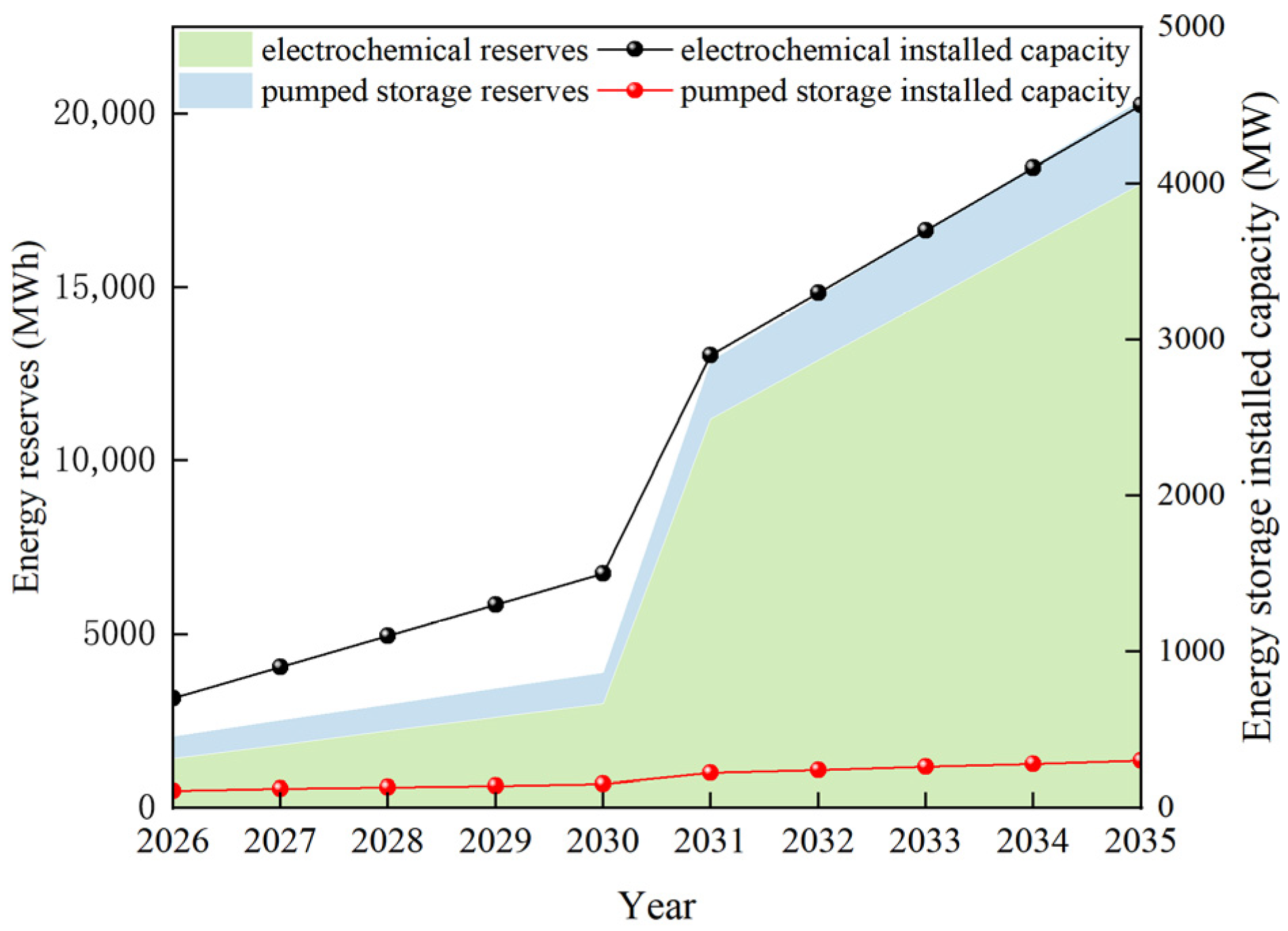

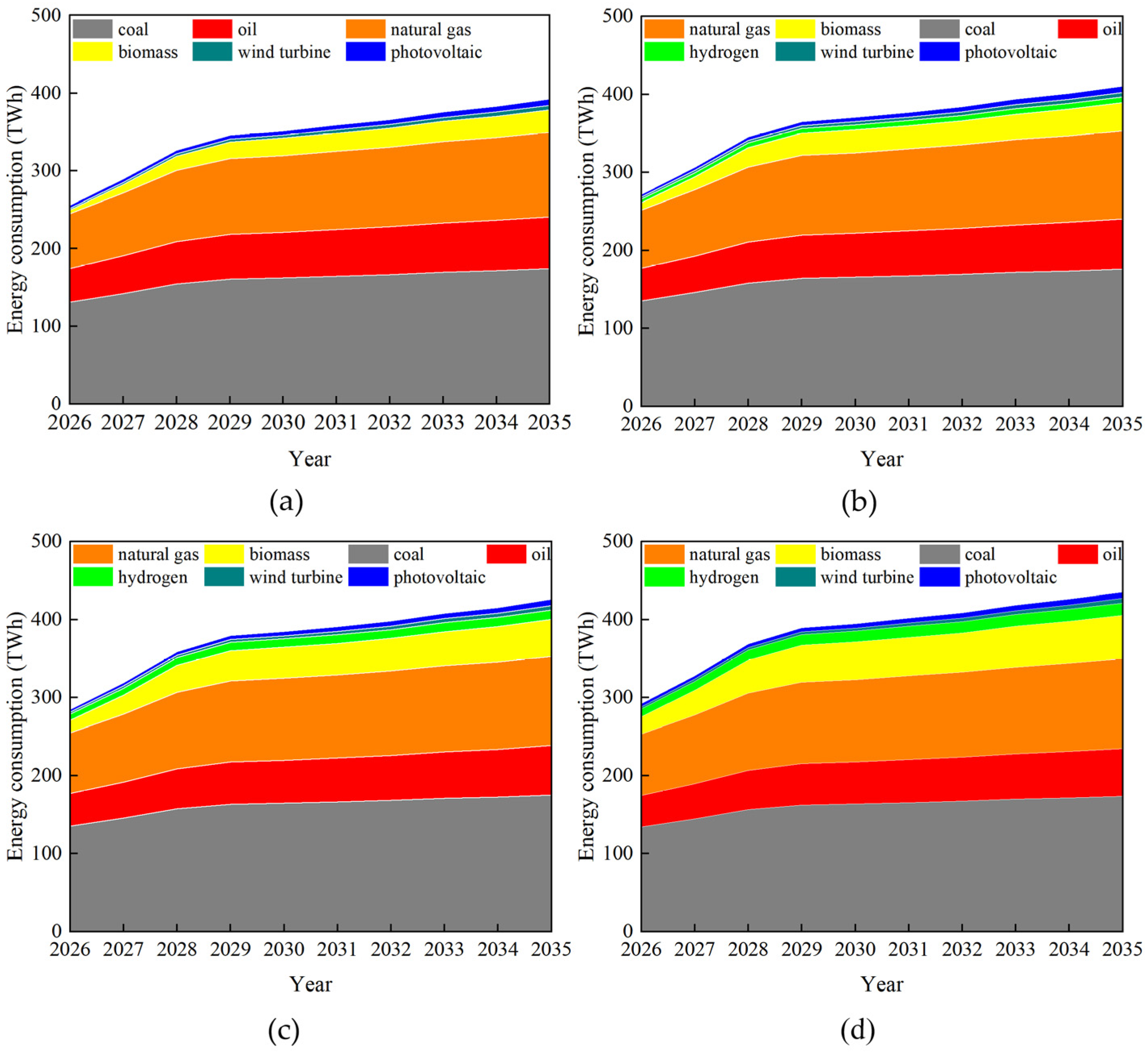
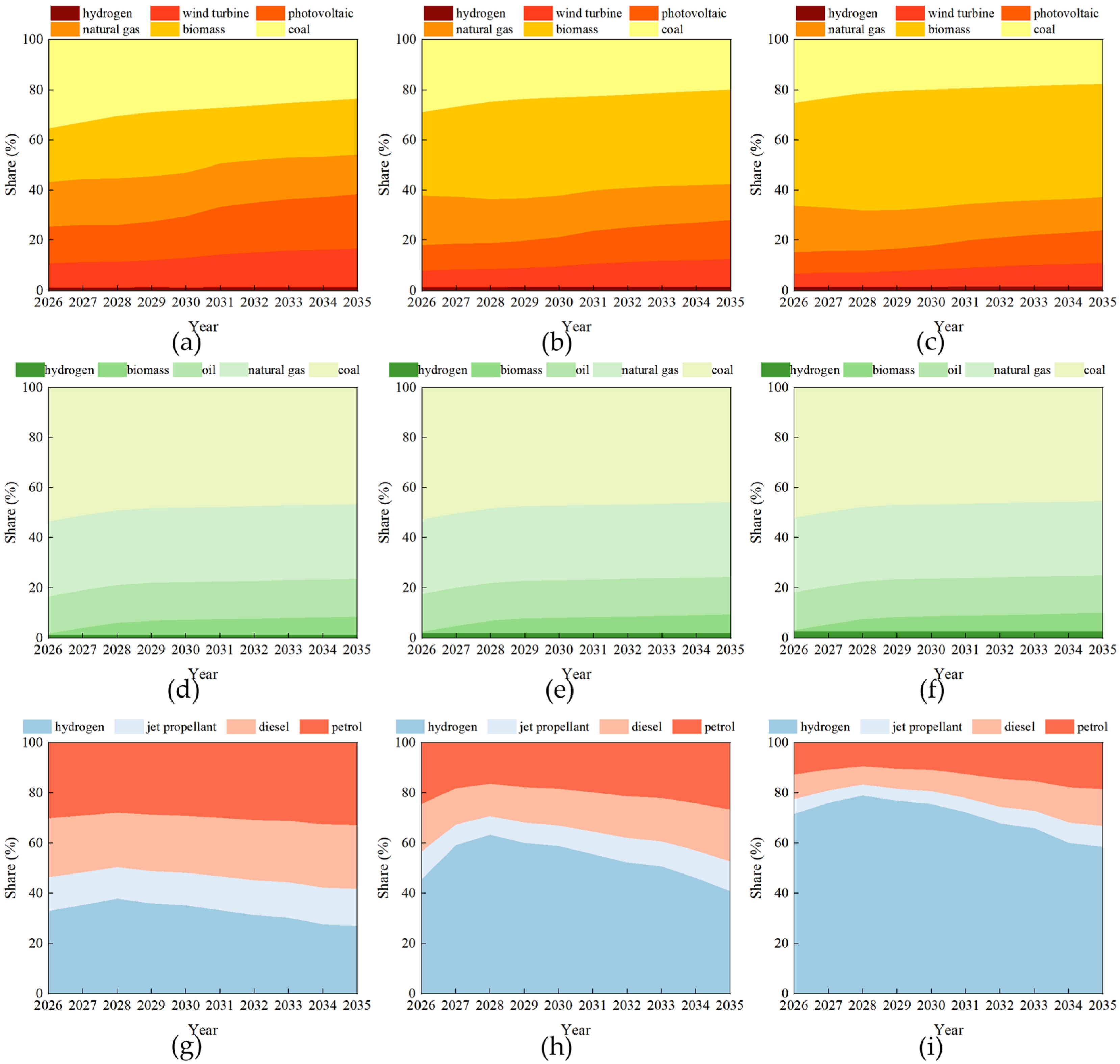
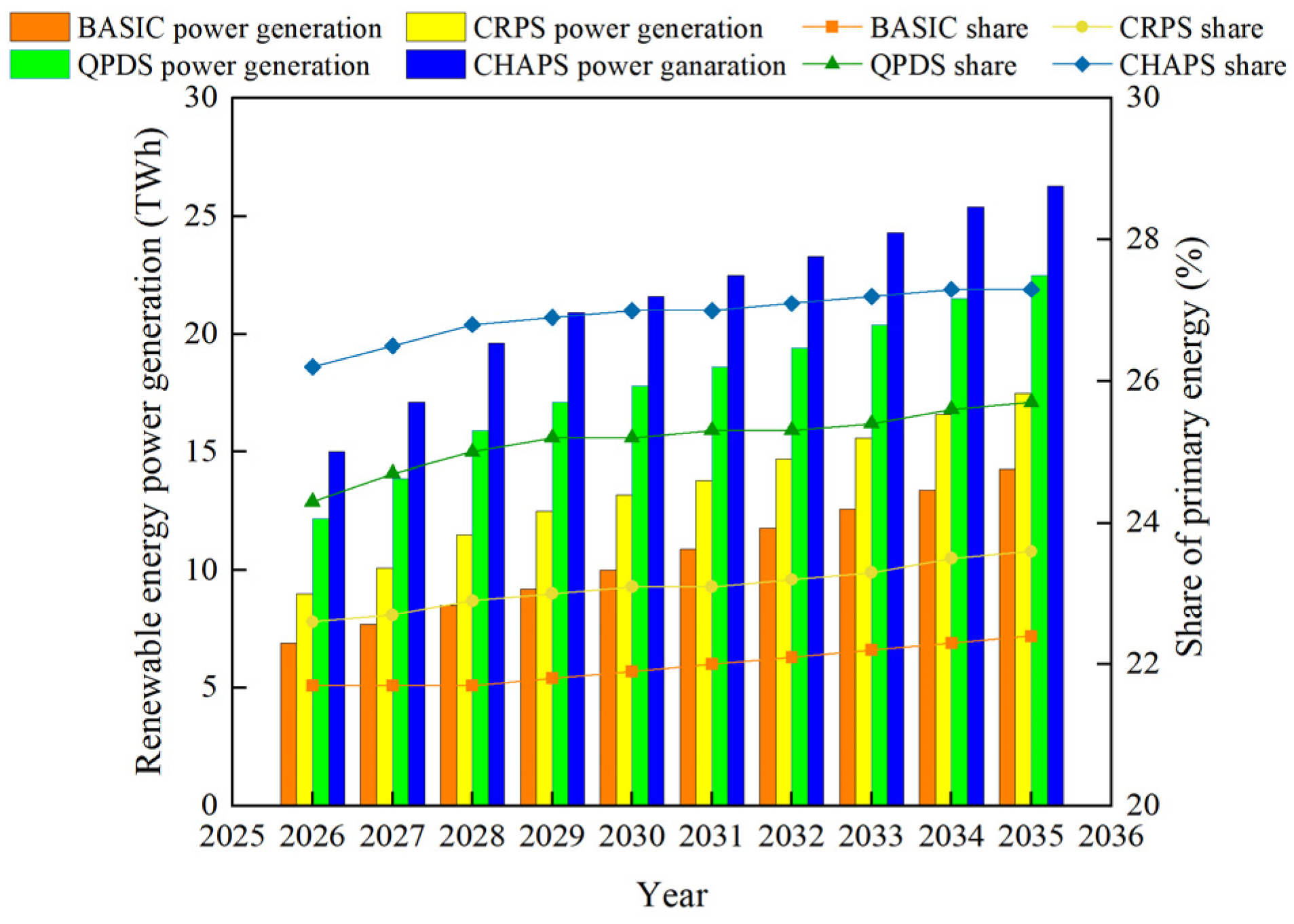

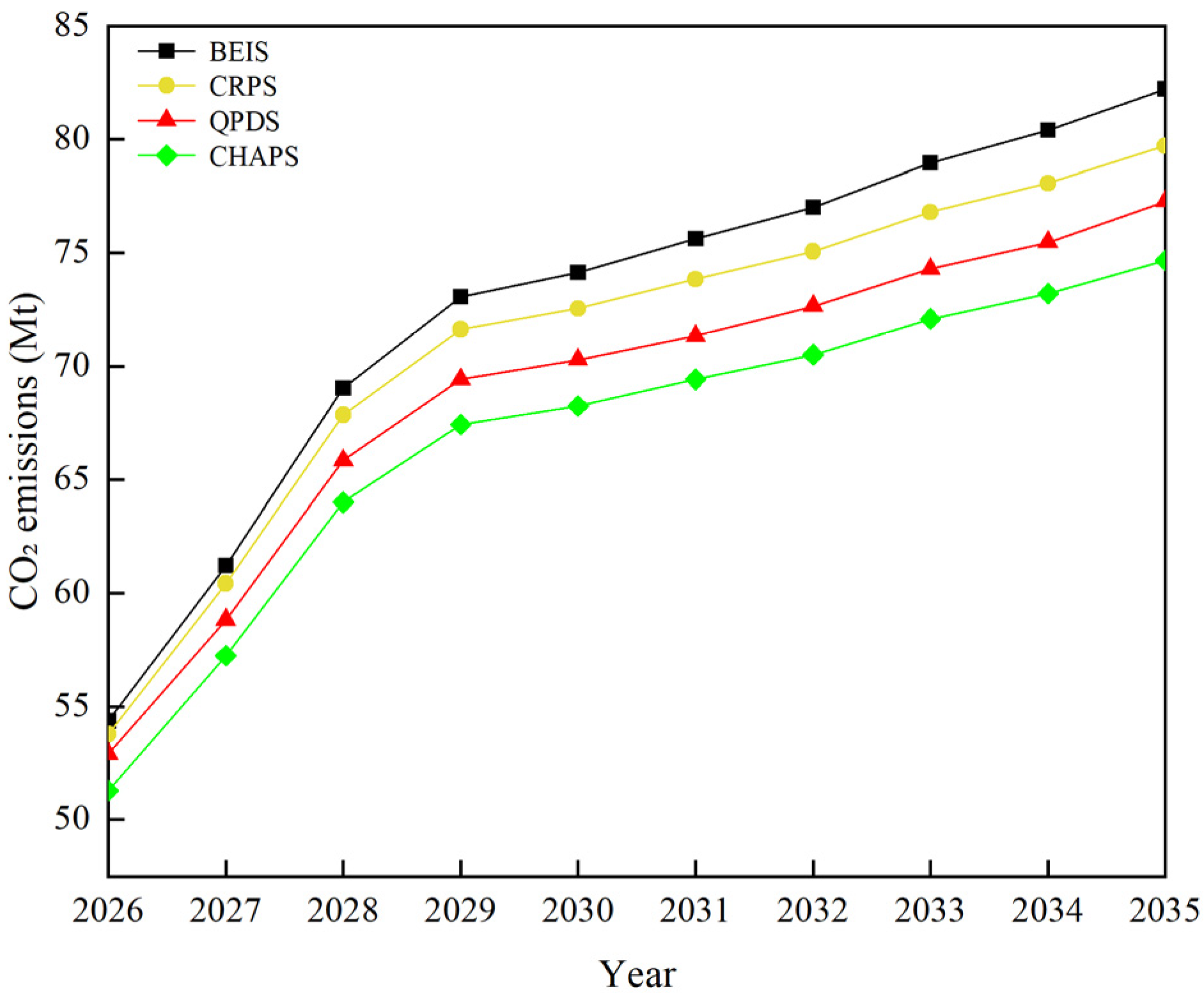
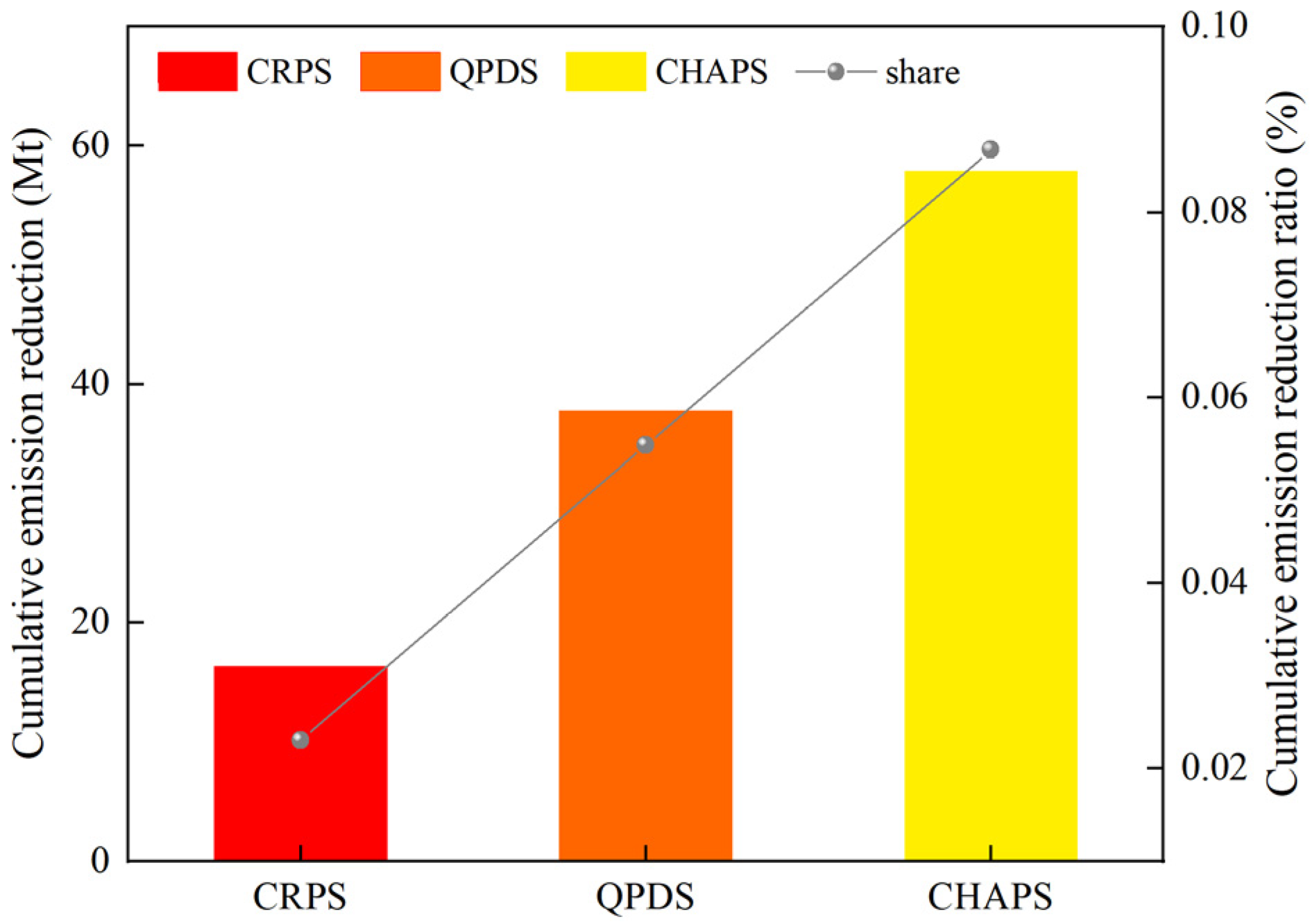

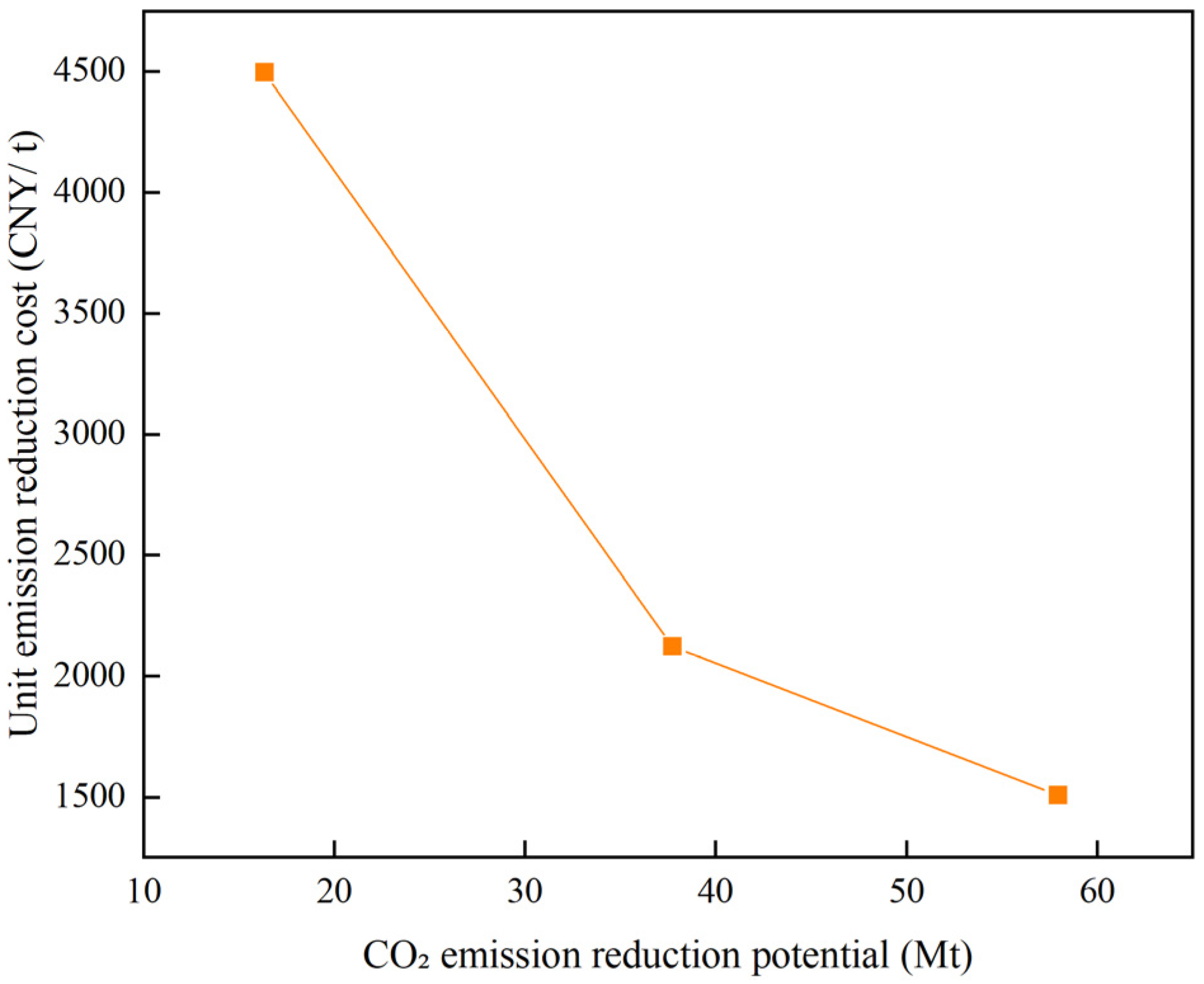

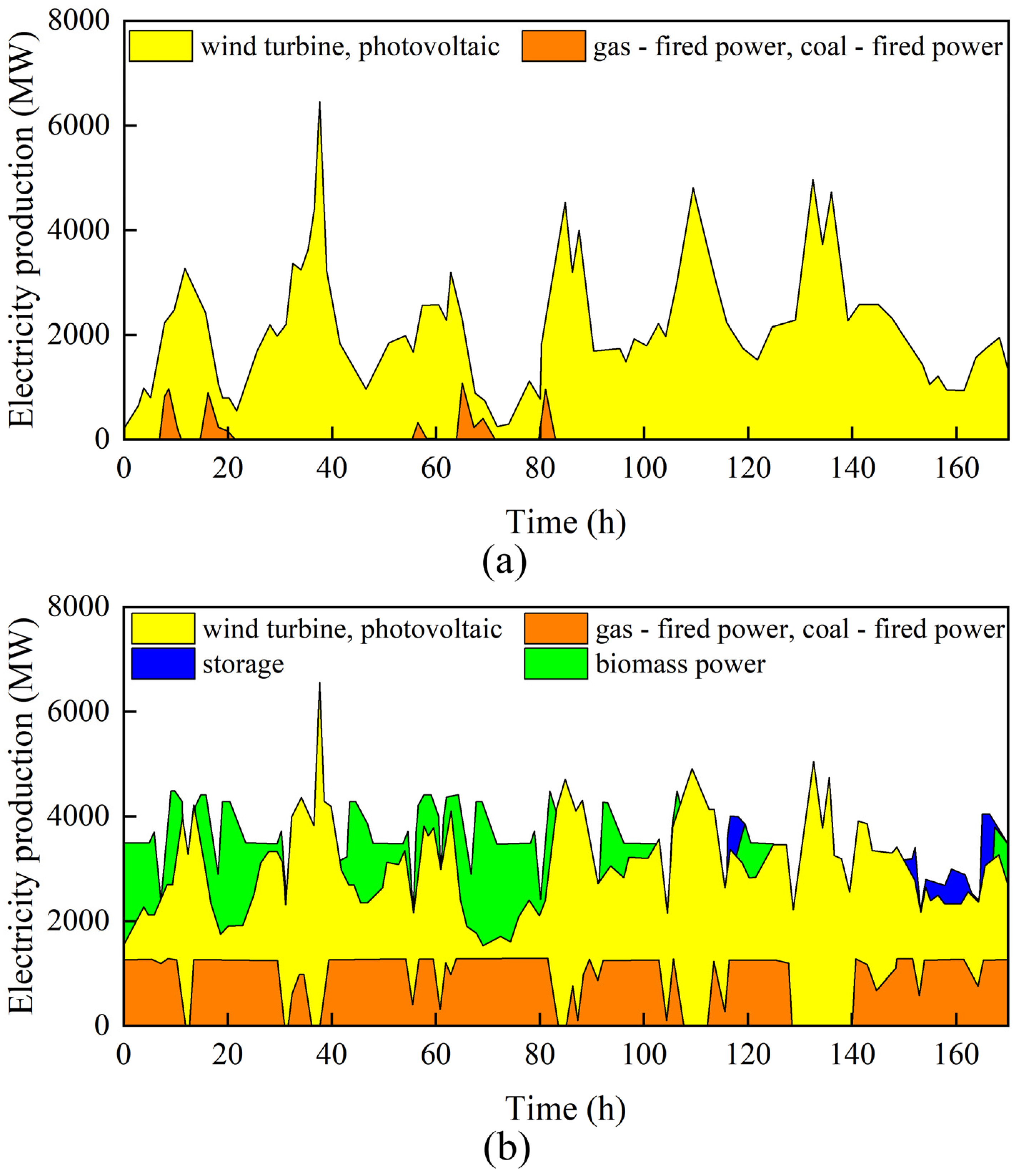
| Hydrogen Energy in Different Sectors | CRPS (TWh) | QPDS (TWh) | CHAPS (TWh) | |
|---|---|---|---|---|
| FTC | 403.530 | |||
| Htotal,n | 12.106 | 20.177 | 26.229 | |
| Electricity | Helec | 0.726 | 1.211 | 1.574 |
| Melec,ng | 0.218 | 0.363 | 0.472 | |
| Melec,co | 0.218 | 0.363 | 0.472 | |
| Transport | Htrans | 4.116 | 6.860 | 8.918 |
| Mtr,di | 0.988 | 1.646 | 2.140 | |
| Mtr,pe | 1.482 | 2.469 | 3.210 | |
| Industry | HInd | 6.658 | 11.097 | 14.426 |
| MInd | 3.995 | 6.658 | 8.656 | |
| Hinj | 0.605 | 1.009 | 1.311 | |
| Minj | 0.363 | 0.605 | 0.787 | |
| Fuel Types | Coal | Fuel Oil | Natural Gas |
|---|---|---|---|
| CO2 emission factors (kg/GJ) | 90.9 | 75.8 | 61.8 |
| Independent Variable | Setting Basis | Annual Growth Rate Setting |
|---|---|---|
| GDP per capita | Jinan City “14th Five-Year Plan” economic and social development requirements to reach 7%. | 7.59~6.54% |
| Population | The Jinan Territorial Spatial Master Plan (2021–2035) proposes that by 2035, the resident population in the city area will be strictly controlled within 12 million people. | 5.23–6% |
| Percentage of secondary sector | Responding to the national energy-saving and emission reduction policy the proportion of secondary industry will decline. | −0.36~−0.54% |
| Urbanization rate | Jinan City, “14th Five-Year Plan” economic and social development requirements to reach 58%. | 2.45~1.92% |
| Consumer price index CPI | Consumer index increase controlled at around 3%. | −4.06~−2.06% |
| Equipment | Initial Investment Cost (MCNY/MW) | Fixed O&M Cost (MCNY/MW) | Period (Years) |
|---|---|---|---|
| Wind turbine | 8.50 | 0.12 | 10 |
| Photo votaic | 3.80 | 0.05 | 10 |
| Biomass power | 3.50 | 0.30 | 10 |
| Gas-fired power | 5.50 | 0.18 | 10 |
| Coal-fired power | 12.0 | 0.22 | 10 |
| Control Group | CRPS (Billion CNY) | QPDS (Billion CNY) | CHAPS (Billion CNY) |
|---|---|---|---|
| RMSE | 30.57 | 53.40 | 67.09 |
| Hydrogen Scenario | Cumulative Cost (Billion CNY) | Cumulative CO2 Emissions (Mt) | Cumulative CEEP (TWh) | Cumulative RES Generation (TWh) |
|---|---|---|---|---|
| CRPS | 8744.43 | 709.67 | 5.19 | 134.5 |
| QPDS | 8983.30 | 688.27 | 1.15 | 179.3 |
| CHAPS | 9124.12 | 668.08 | 0.49 | 216 |
| Evaluation Indicators | Cumulative Cost (Billion CNY) | Cumulative CO2 Emissions (Mt) | Cumulative CEEP (TWh) | Cumulative RES Generation (TWh) |
|---|---|---|---|---|
| Weighting factor | 0.2814 | 0.2502 | 0.2233 | 0.2451 |
| Evaluation Indicators | CRPS | QPDS | CHAPS |
|---|---|---|---|
| Relative posting progress | 0.4039 | 0.3154 | 0.5961 |
Disclaimer/Publisher’s Note: The statements, opinions and data contained in all publications are solely those of the individual author(s) and contributor(s) and not of MDPI and/or the editor(s). MDPI and/or the editor(s) disclaim responsibility for any injury to people or property resulting from any ideas, methods, instructions or products referred to in the content. |
© 2025 by the authors. Licensee MDPI, Basel, Switzerland. This article is an open access article distributed under the terms and conditions of the Creative Commons Attribution (CC BY) license (https://creativecommons.org/licenses/by/4.0/).
Share and Cite
Wan, H.; Liu, Y.; Zhou, X.; Gao, B.; Liu, J. The Hydrogen Trade-Off: Optimizing Decarbonization Pathways for Urban Integrated Energy Systems. Buildings 2025, 15, 3014. https://doi.org/10.3390/buildings15173014
Wan H, Liu Y, Zhou X, Gao B, Liu J. The Hydrogen Trade-Off: Optimizing Decarbonization Pathways for Urban Integrated Energy Systems. Buildings. 2025; 15(17):3014. https://doi.org/10.3390/buildings15173014
Chicago/Turabian StyleWan, Huizhen, Yu Liu, Xue Zhou, Bo Gao, and Jiying Liu. 2025. "The Hydrogen Trade-Off: Optimizing Decarbonization Pathways for Urban Integrated Energy Systems" Buildings 15, no. 17: 3014. https://doi.org/10.3390/buildings15173014
APA StyleWan, H., Liu, Y., Zhou, X., Gao, B., & Liu, J. (2025). The Hydrogen Trade-Off: Optimizing Decarbonization Pathways for Urban Integrated Energy Systems. Buildings, 15(17), 3014. https://doi.org/10.3390/buildings15173014








